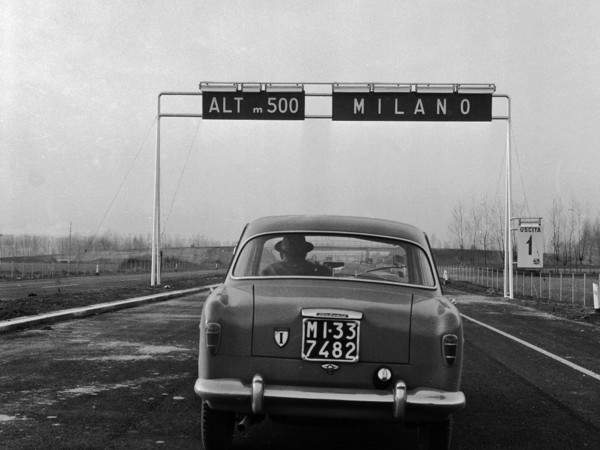From Nov. 6, 2019 to Feb. 9, 2020, Palazzo Morando | Costume Moda Immagine in Milan will host the exhibition Milano Anni ’60 that traces the history of an unrepeatable decade that consecrated the Lombard capital as one of the world capitals of creativity capable of assuming the role of moral and economic leader of the country.
Driven by the economic boom, Milan suddenly found itself experiencing an irrepressible cultural ferment, characterized by an unprecedented design force and the desire to leave behind the horrors of the war in a definitive way.
The great season of music in Milan opened with Billie Holiday ’s 1958 concert at the Smeraldo and would happily continue with all the greats of jazz from Duke Ellington to Thelonius Monk to Chet Baker and Gerry Mulligan, who were at home in Milan. Pop music also experienced a golden period with the Beatles ’ concert at the Vigorelli in 1965 and the Rolling Stones ’ at the Palalido in 1967, which sealed Milan’s role as a modern city ready to welcome the greatest protagonists of pop and rock music from across the Atlantic and overseas.
These were years of great artistic fervor with thework of Lucio Fontana and Piero Manzoni, milestones of Italian design such as Marco Zanuso, Bruno Munari, Vico Magistretti, Achille Castiglioni, and Bob Noorda, and great exponents of photography such as Roberto Polillo, Carlo Orsi, Uliano Lucas, Gianni Greguoli, Fedele Toscani, Fabrizio Garghetti, Giorgio Lotti, Emilio Frisia, Cesare Colombo, Ernesto Fantozzi, Paolo Monti, Silvestre Loconsolo, Piero Raffaelli, of intense nightlife of jazz clubs with Giorgio Gaber and Enzo Jannacci. These are just some of the protagonists of the Milanese scene who contributed to the enchantment of that decade. A dream from which the city awoke abruptly, on December 12, 1969, with the bombing of the Banca Nazionale dell’Agricoltura in Piazza Fontana.
Curated by Stefano Galli, produced in collaboration with the Municipality of Milan | Culture, Historical Museums Directorate and the Milan Police Headquarters, organized by MilanoinMostra under the patronage of the State Police and the Lombardy Region, the exhibition features photographs, posters, magazines, furniture, design objects and much more, which will bring to life the atmosphere of that era.
The exhibition itinerary, divided into sections, opens with images of the new Milan, whose face is changing thanks to new constructions, such as the Pirellone, the Velasca Tower, the Municipal Technical Services Tower, the Directional Center, the Galfa Tower, but also the birth of the suburban neighborhoods, including Quarto Oggiaro, Olmi, Gallaratese, Gratosoglio, and Comasina, the latter of which waslatter begun in 1953 and completed in 1960, the most important building intervention in those years in Italy with its 11.000 rooms and 83 buildings.
Photographs and magazines of the period document the economic boom, with the construction of Milan’s ring roads, the Milan-Piacenza section of theA1 highway, infrastructures that brought faster movement of goods with greater growth of businesses; famous names in advertising graphics were called upon to rethink the brands of the new and renovated businesses, starting with Franco Albini and Bob Noorda ’s fundamental project for the Milan Underground.
Numerous objects help evoke the great season of design, with such masters as Bruno Munari, Marco Zanuso, Vico Magistretti, Enzo Mari, Achille Castiglioni, Sambonet, Joe Colombo, and Gio Ponti. The history of the Milanese companies involved in this resounding season is told. Among them are Brionvega, Cassina, Zanotta, Kartell, Tecno, Fontana Arte, Artemide, Flos, Arflex, and Danese.
The world of culture, art galleries, and cabaret also experienced a heyday. And of course music, particularly jazz, which found a home in numerous clubs scattered around the city, such as Taverna Mexico, where the best exponents of this genre performed.
As early as the late 1950s, Milan also became a popular place to hold memorable concerts, such as those of Billie Holiday at the Smeraldo, the Beatles at the Vigorelli, the Rolling Stones at the Palalido, and Jimi Hendrix at the Piper, but it was also the stage that saw artists such as Enzo Jannacci, Giorgio Gaber, Adriano Celentano, and Patty Pravo make a name for themselves.
The late 1960s then marked the birth of protest, from student uprisings in the universities, resulting in the occupations of the Statale and the Cattolica, to pickets in the factories and strikes.
The exhibition closes with the section dedicated to Piazza Fontana and the end of the dream, with photographs of the massacre and the funeral, accompanied by documents and some objects related to this tragic event to whose research and selection, at the archives of the State Police and elsewhere, the Milan Police Headquarters collaborated.
Milano Anni 60 at Palazzo Morando | Costume Moda Immagine is the new exhibition appointment of a journey that began with Milano tra le due guerre. Discovering the City of the Navigli through the photographs of Arnaldo Chierichetti (2013) and continued with Milan, City of Water (2015) and Milan, History of a Rebirth. 1943-1953 from the Bombing to the Reconstruction (2016), Milan and the Mala (2017) and Milan and the Cinema (2018).
A journey in stages through the history of a city, through its specificities, social events, and the many cultural and entrepreneurial initiatives that radically changed its face.
For all information you can visit the official website of Palazzo Morando.
Pictured: Fedele Toscani, Autostrada del Sole under construction, 1958
Source: press release
 |
| What was Milan like in the 1960s? An exhibition at Palazzo Morando tells us. |
Warning: the translation into English of the original Italian article was created using automatic tools. We undertake to review all articles, but we do not guarantee the total absence of inaccuracies in the translation due to the program. You can find the original by clicking on the ITA button. If you find any mistake,please contact us.